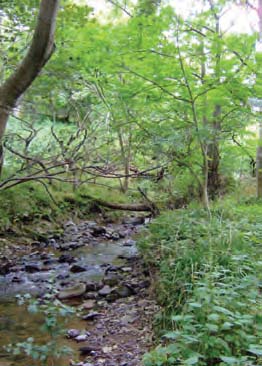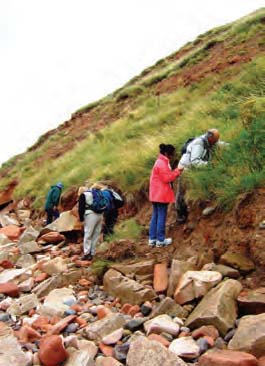|
Pease Dean is a deep wooded valley (Fig. 1) on the coast in the north-east corner of Berwickshire (Grid reference NT 79/90), which includes some ancient woodland. It is a Scottish Wildlife Trust (SWT) reserve, and SWT were happy, indeed keen, for a party of conchologists to visit, as not much seemed to be known about the slugs and snails at this site. Among other things, we had hopes of finding some rare ancient woodland species. Being within easy reach of Edinburgh, our visit was a convenient sequel to the indoor meeting held at the National Museums Scotland the previous day. Not everyone who attended the Edinburgh meeting was able to come to Pease Dean, but some people came specially for the field meeting only, from as far away as Glasgow, and even Ecuador (though the young lady in question was working in Edinburgh at the time!). To reach the Pease Dean reserve, you leave the car park by the Pease Bay caravan site, cross the lane, and then cross a small field before entering the wood. The field is outside the reserve, but nevertheless yielded our first exciting finds. Here was a specimen of Merdigera obscura, which is rather sparsely distributed in Scotland, and the first of several specimens of Boettgerilla pallens, apparently a new vice-county record for Berwickshire. We were lucky to have Barry Colville with us, who was able to tell us about the original discovery of this species in Britain in 1972. A large plastic sheet lying on the ground here had quite a few large slugs and snails under it, including Arion cf. rufus and Helix aspersa. Once we had entered the wood, we found a moderate number of species, including more Boettgerilla pallens, and sieving leaf litter produced, among other things, a large number of both species of Carychium. However, no characteristic ancient woodland species had been discovered by lunchtime. After lunch we paid a short visit to Pease Bay (Fig. 2), just a few yards away, where Barry hoped to find Pupilla muscorum. In this we were unsuccessful, but we did find a few more species we hadn’t found in the wood, including Candidula intersecta, which is essentially a coastal species in Scotland. On the way back, we found the freshwater limpet Ancylus fluviatilis at the ford where the stream that runs through Pease Dean crosses the road before it reaches the sea. The rest of the afternoon was spent in a part of the Pease Dean reserve that we hadn’t visited in the morning. Here, Barry Colville collected a good lot of leaf litter, which proved to be very rich when he analysed it later. There were a large number of molluscs, including the ancient woodland species Leiostyla anglica and Perforatella subrufescens. Altogether, the day’s snailing produced no less than 41 species, in spite of the dry weather; of these, 35 were in the reserve. Several species were apparently new to the area. This is probably not the maximum number of species possible; with more luck, and damper conditions, we might have found two more ancient woodland species: Limax cinereoniger and Spermodea lamellata. There are apparently no recent records for the latter in the whole of Berwickshire, so Pease Dean would be well worth another visit. |
|
Pease Dean, Berwickshire 9th September 2007
Issue
16
Page
17

 Figure 1. Pease Dean SWT reserve, Berwickshire
Figure 1. Pease Dean SWT reserve, Berwickshire Figure 2. Conchologists at work in Pease Bay, Berwickshire, 9th September 2007
Figure 2. Conchologists at work in Pease Bay, Berwickshire, 9th September 2007